Hahn and Wolters’ New Book About Women Engineers at Illinois Poised to Inspire, Retain, and Recruit Women Engineers
August 30, 2018
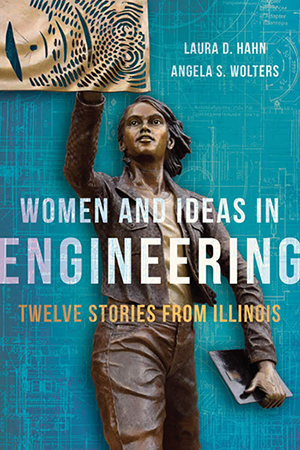
The cover of Laura Hahn and Angie Wolters' book, Women and Ideas in Engineering: Twelve Stories from Illinois.
Several years ago, Laura Hahn (currently the Director of Engineering’s Academy for Excellence in Engineering Education [AE3]) stumbled across the book, Men and Ideas in Engineering: Twelve Histories from Illinois. On her way to show it to Angie Wolters (currently the Women in Engineering director), she had an epiphany, and determined, “Oh, I know what we have to do: we have to write a sequel!” So she asked Wolters, “Do you see this?” and at that moment, the idea for Women and Ideas in Engineering: Twelve Stories from Illinois was born.
The original book was published in 1967 for the university’s centennial celebration. Since at the time of their discussion, the university’s 150th anniversary was imminent, they thought, “What better thing to do than to write the sequel,” Wolters confesses. “In reviewing the book itself, there were no women celebrated within the cover of Men and Ideas, so it was our chance to say, ‘Hey, let's tell their story!’” The goal was to have the sequel ready for the university’s upcoming Sesquicentennial in 2017.
So the two began to brainstorm, then crowd source regarding women who should be included in the book. They approached numerous university folk for suggestions, including departmental communications specialists familiar with present day women; archivists, who were particularly knowledgeable about the early years of the university; even university retirees.
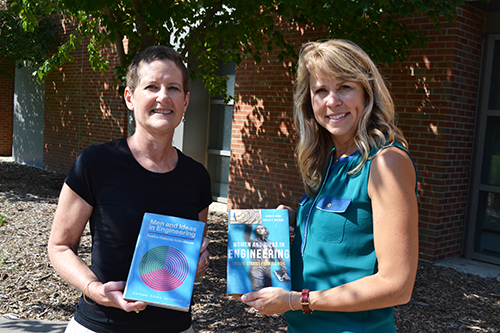
Laura Hahn (left) with the book Men and Ideas in Engineering: Twelve Histories from Illinois and Angie Wolters (right) with their book Women and Ideas in Engineering: Twelve Stories from Illinois.
After chatting with numerous enthusiastic people from the College of Engineering and beyond, it quickly became apparent that the book should be written by more people than just the two of them: “The stories were going beyond us,” Hahn explains. “We realized that all of these people had great voices to contribute.”
So while the two are named as authors, they say they’re more like co-editors, and credit the university community for the book. Key people in the college and the university archives who worked with them substantially were Celia Elliot in Physics, Bethany Anderson from the university archives, and Cinda Heeren, formerly in Computer Science.
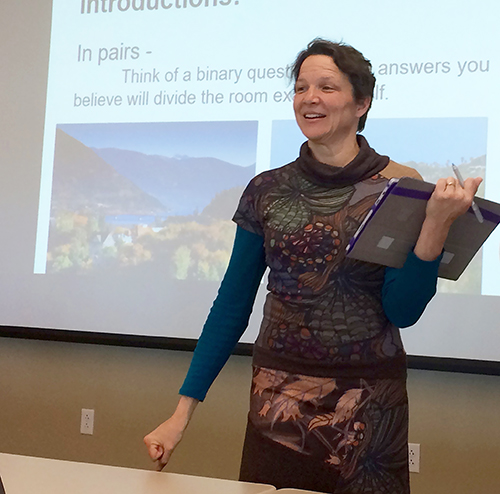
Cinda Heeren teaching a class in CS (photo courtesy of Angie Wolters).
How did they determine whom to include in the book? As Hahn and Wolters chatted with more and more folks, the names of certain women salient in their fields were reiterated over and over and emerged as frontrunners. “We talked to several retirees, some administrators from the college,” says Laura, “and just started listening to what they had to say. And we heard common names after a while: Judith Leedman, Nacy Sotos, Roselin Yalo,” says Hahn. So they started an excel spreadsheet.
Wolters discloses that in the beginning, they were concerned that they would struggle to find 12 stories. But then the list of names of women whom they felt should be included quickly grew beyond the twelve male engineers documented in the original book. Having unearthed so many women that they couldn’t possibly leave out, they devised a better way to organize the book. Rather than just telling the stories of 12 different people like Men and Ideas, they decided to organize the stories in chapters with different themes. For example, the chapter on women in computing tells multiple stories.
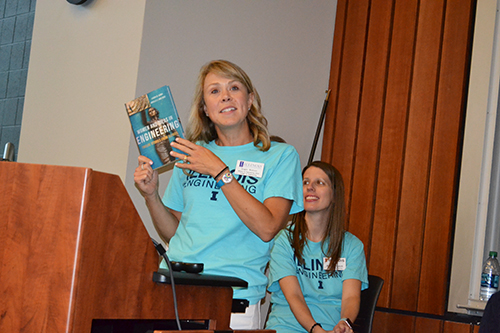
Angie Wolters promotes the book during the recent WIE Orientation.
So they settled on chapters emphasizing important areas, citing several women whose stories stood out. Their main criterion in choosing the women to be included was balance—early pioneers, present-day leaders, the different engineering disciplines, as well as other relevant emphases. Then chapter themes were crafted to describe the many relevant women engineers they’d found during their search.
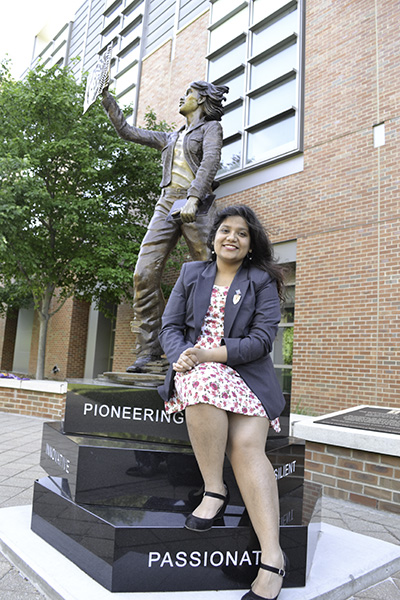 Former ECE graduate student Sakshi Srivastava, by the Quintessential Engineer. Srivastava, who, along with Wolters, spearheaded having the statue of a female engineer erected on campus, is featured in the "Inspiring the Next Generation" chapter.
Former ECE graduate student Sakshi Srivastava, by the Quintessential Engineer. Srivastava, who, along with Wolters, spearheaded having the statue of a female engineer erected on campus, is featured in the "Inspiring the Next Generation" chapter.
For instance, the first chapter, “Engineers Who Happen to Be Women: The First 150 Years,” mostly focuses on “those first 100 years that didn't get noticed in the [Men and Ideas] book,” Hahn says. The “Early Inspiration: Faculty Pioneers” chapter highlights our first female faculty pioneers. Other chapters include “Research Orientations,” “Relentless Innovators,” “Acclaim in Bioengineering and Medicine,” “Touching the Sky (aerospace), “Women’s Work: Computing,” plus how Illinois’ women engineers are facing “Global Challenges” and finding solutions.
They also have a chapter, “Do Engineers Have to Engineer?” about women engineers who went on to do things a little differently than just the standard engineering design or research. There’s a chapter on “Mentors and Mentoring,” and the “Inspiring the Next Generation” chapter includes women who are doing just that. This chapter is where Wolters and Hahn tell the story of Sakshi Srivastava (a former Illinois Engineering grad student) and her pivotal role in the creation of the female engineer statue, The Quintessential Engineer. The final chapter, “Foundations for the Future,” features a cohort of five female faculty members in Mechanical Science and Engineering (MechSE) who all started at the same time in the fall of 2014. “So they're paving the way for the future,” says Hahn.

Dean Sue Larson (right), who added the Reflections section on the "Mentors and Mentoring" chapter (photo courtesy of Angie Wolters).
The two say that the makeup of each chapter is unique and may include multiple voices. For instance, the chapter on women in computing includes the story of a woman from the past written by Laura Hahn. However, one of the stories of a woman from the present was adapted from an essay written by one of Electrical and Computer Engineering’s communications staff. “So their voice is in there,” Hahn says. Many of the chapters end with a first-person reflection. In the case of the women in computing chapter, it ends with a section by Cinda Hereen, a Computer Science (CS) stalwart who was devoted to encouraging women in CS during her time at Illinois. “So Cinda's voice is shared there to help tell the story of women in computing and her version of it,” Hahn explains.
More than four years in the making, the sequel, besides, of course, giving equal play for women, was intended to motivate and inspire women. The two see the book as viable to not only contribute to the retention of female students in engineering, but also as a recruitment tool.
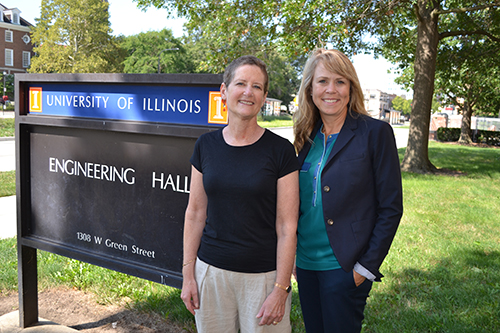
Laura Hahn (left) and Angie Wolters (right) in front of the Engineering Hall sign.
“When it comes to recruiting students here, when it comes to recruiting faculty, keeping students, or keeping faculty, the whole nation is looking to have more women in STEM. So we're all competing for this current finite pool,” says Wolters. “But we want to keep growing that.” So that's really what they envision the book doing, inspiring and motivating current students reading their book. “That's why we did this,” she continues. “From my perspective with Women in Engineering, this is not only a retention piece, but it is also a recruitment piece.”
Not content to rest on their laurels and eager to broaden the book’s impact, this fall, the two are also teaching a class based on the book, ENG 298, where they hope to expand its inspiration, retention, and recruitment potential. So during the course, they’ll share the stories of these inspiring women a chapter at a time, inviting someone featured in or who contributed to the chapter to be a guest speaker for the class.
As a writer who’s never met a quotation I didn’t like, I consistently struggle with too-long articles. (Note the length of this one!) So how were Hahn and Wolters able to pare the work down to a reasonable size? How difficult was that, knowing there were all these people contributing and all these amazing women who deserved recognition?
“We made some hard decisions,” Hahn admits. She says there were some people that they thought should probably be in the book that they had to leave out. “We went for a balance of departments as well as of eras, so we had representative women from all of the departments in the college as well as across time. There were some departments where they could have a whole book in and of themselves, so I think a lot of it was going for balance.”
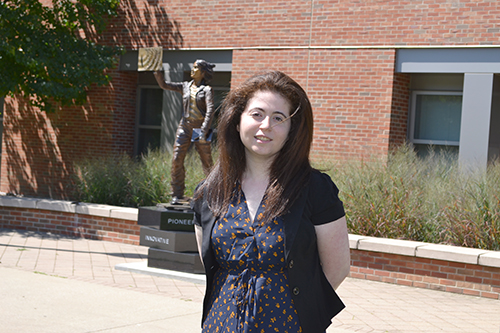
One of the women engineers featured in the book, Amy Doroff, a recent ISE graduate, in front of the Quintessential Engineer statue.
Ironically, they haven’t really left anyone out. While the book is officially in print, like the Energizer Bunny, it keeps going and going and going—rather growing, growing, growing, as the two are still adding to the book virtually. For instance, they’re developing a companion website featuring women they couldn't fit into the book. Hahn indicates that of the women listed in that initial Excel spreadsheet, she and Wolters were probably only able to highlight about a third of the women in the book, so they've continued writing those stories while the book was in publication, which are published on the Women in Engineering website. In fact, every Wednesday is Woman Crush Wednesday on the Women in Engineering Facebook page, where they release another story of one of the women.
Additionally, as part of the final project for their class, students will interview a woman engineer, faculty member or alum and write a vignette, which will be posted on the website.
As a further extension of the entire project’s recruiting potential, the two envision this website to have a burgeoning impact as a tool to help recruit women into engineering. For instance, the extra stories they and the students will be writing will be organized on the site by majors and available for potential students who are curious about what a career in a given discipline might be like.
“Quite often when a prospective student comes to campus and visits,” Hahn explains, “they say, ‘Well, how do I know about these majors? What would I do with this career?’ So now we have actually created a spot where these students can go and say, ‘I've heard about mechanical engineering. I'm interested in this,’ and they can actually see and click on mechanical engineering and the five different stories we have there of different students, different alumnus, different faculty relative to the major.”
In addition to their own list of women, they’re also highlighting things other communication departments (including I-STEM) have written. “Wherever the stories are being told, we're kind of cataloging those and continuing to add to it,” Hahn says.
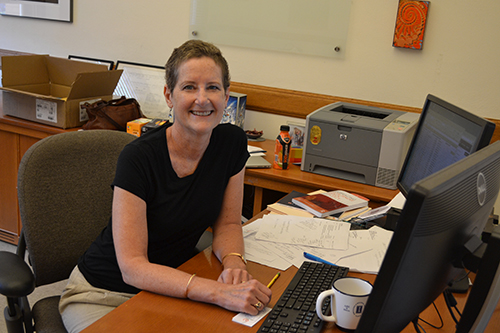
Laura Hahn working on her computer.
What Hahn found most rewarding about the book was the enthusiasm and ownership of the various contributors. “We had a lot of contributors and a lot of people really enthusiastic about the book and the project, and that's what energized me about it —working with everyone and seeing everyone's excitement.”
Of course, the two most enthusiastic about the project were Hahn and Wolters themselves. “Laura and I just got so excited!” Wolters admits. “We would write about one woman and be like, ‘You've got to read what I just put together!’ Like when I wrote about Barbara Crawford Johnson, and all that she did, it was something! I was like, ‘Laura has got to read it!’”
Barbara Crawford Johnson was the first woman to get a degree in General Engineering before it became Industrial and Enterprise Systems Engineering. Wolters shares a further anecdote related to the ISE pioneer. “The cool thing about this story…” Wolters continues, then relates how they’d been in contact with the ISE communications office about one of their young alums highlighted in the book. In telling them the story of Barbara Crawford Johnson, ISE discovered, “That's a woman that they hadn't highlighted. The department hadn't ever really told her story. So now, in their alumni newsletter, they're going to be sharing excerpts from the book of her story to share it with their alumni.”
This type of cross-inspiration has occurred regularly as a result of the book. “It's worked both ways,” Wolters reports. “Their stories inspired us. Our stories are inspiring them to share others, and there really has been a collaborative effort.”

Angie Wolters working at her computer.
The two admit that writing the book has been an emotional experience. In fact, contrary to the style of its predecessor, Men and Ideas, it’s much more personal. “We focused on referring to all of the women by first name,” Wolters acknowledges, “because we were not only telling their engineering story, we were telling their personal story, and so it's a bit more personal…We wanted our women students that read it to be able to relate to the women in the book and our feedback.”
While women are sterertypically pegged as being emotional (who wouldn't “get teary-eyed” when reading about female Illinois engineering pioneers who have paved the way?), Wolters says one emeritus engineering professor admitted that he too had “found himself emotional…while reading these stories and realizing the challenges that these women had.”
Despite the years of hard work, the two admit that they’ve found the entire process quite meaningful. As Hahn mentioned earlier, she tremendously enjoyed the collaboration. “Part of the rewarding part for me was working with people across the college on the project and seeing their excitement about it. I really liked that part.”
She also appreciated being privy to all of the women’s stories. “Hearing specific stories and anecdotes that really reflect what Angie said about the challenges that women have overcome is very inspiring. Things that we almost take for granted today—that women have an equal place at the table, things to contribute—that hasn't always been the perspective. Having that be reinforced by actual examples and stories is pretty neat.”

Laura Hahn (left) and Angie Wolters (right) with their book in front of the Quintessential Engineer statue.
Wolters says one of the most rewarding things about writing the book was collaborating with Laura Hahn. “Being able to collaborate with Laura who had such strengths in writing to compliment my engineering background. I think what I really took away from this project is…how meaningful a collaboration can be.
She also enjoyed experiencing how the project brought the entire College together as a community: “We had all of this positive feedback,” she says. “This is the one project I've worked on that I don't think I ever heard a negative comment, and that was amazing…Anyone we've talked to about this project was enthused, and so it was reassuring to know that our community would be that supportive and that positive.”
In celebration of Women and Ideas, there will be a special unveiling on September 19th from 7:00-8:30 pm at the university Archives, where the two will give an overview of the book. Author Amy Bicks, who wrote Girls Coming to Tech and reviewed the book will be there to introduce the event.
Finally, underscoring their passion for increasing the number of women in engineering, the two are putting their money where their mouth is—they’ve decided to donate the proceeds of the book to Women in Engineering programs.
(The book is available at the Illinois Press, Illini Union Bookstore, Amazon.com, even Walmart, to name a few.)
Story and photos by Elizabeth Innes, Communications Specialist, I-STEM Education Initiative
More: Engineering, Women in STEM, 2018
For additional I-STEM articles about Women in Engineering, see:
- Freshman Women in Engineering Get Ahead of the Curve At WIE Orientation
- New Female Engineer Statue to Inspire Women—Past, Present, and Future—to Embrace Engineering
- Mariano, Pace Encourage Female Engineering Students: "You Too Can Succeed!"
- Pakeltis Sisters Hope to Increase the Number of Women—Change the World Through Engineering
- Devon Goszkowicz: Following Dad's Footsteps to Engineering at Illinois—Blazing Her Own Trail in STEM Outreach
- Cindy and Stephanie Richartz—Keeping It in the Illinois Engineering Family
- WIE Lead Fosters Leadership in Illinois' Women in Engineering













.jpg)
















